*signage encouraging social interaction, held aloft by assistants at the entrances to Art Basel
Returning from the commotion of Art Basel, its “region-wide art week,” and an exploration of Vienna, I’m encouraged to consider the interactive public and private art spheres. Of course, the nature of contemporary art in Europe, as in the USA, fundamentally concerns imaginative modes of integrating art and life, admitting of many fraught connections with the world. Within the urban experience of a deeply historical city such as Vienna one witnesses abundant evidence of a renewed right-wing present. Gilded nationalism appears through imperial eagle symbolism glistening atop national buildings, while the abutting, ever stylish Jugendstil neighborhoods are invaded by inelegant graffiti.
What is art anymore? What is its audience? What is an easier lift for the marketplace, art that is privately scaled and apparently “pure,” or art politically minded and publicly sited, or are these distinctions collapsing, yielding to one another These are among the questions raised and worth probing from first hand exposure to abundant art fairs, held no matter where, globally, they occur, and from the experience of contemporary art in Europe altogether. These timely questions were pressing in my visit to Basel and Vienna this summer.
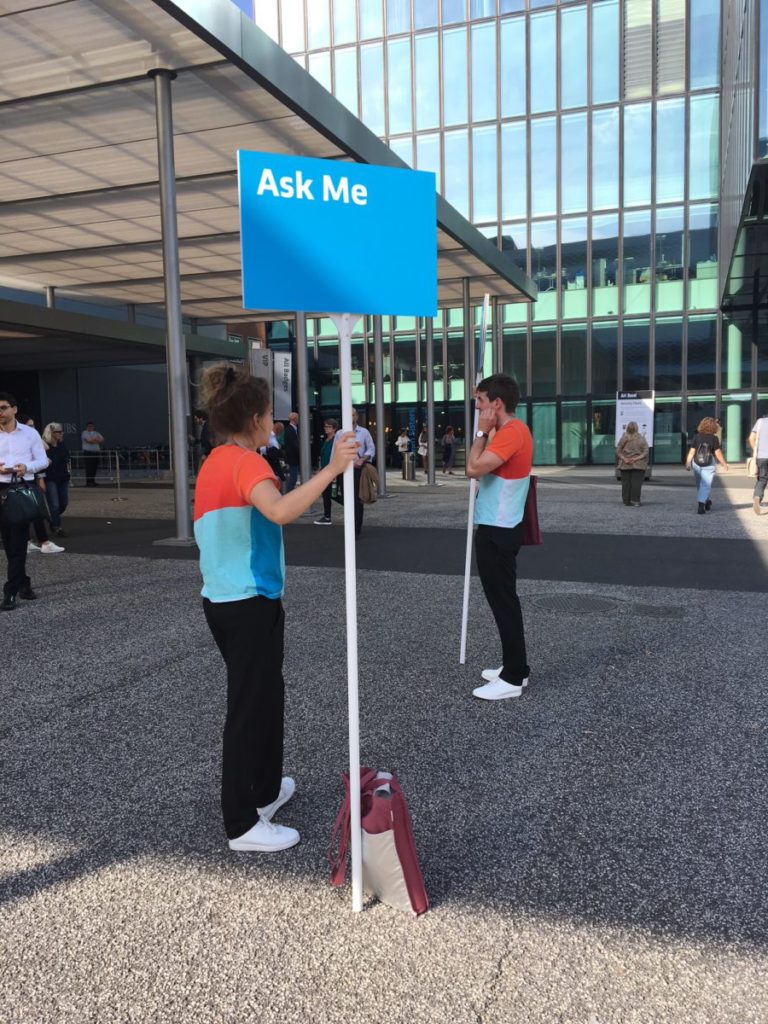
Art Basel Messeplatz. Photo courtesy of Judith Tolnick Champa.
Art Basel, the venerated, almost fifty-year-old fair, is prestigious, prodigious, and globally inclusive. Presented again with lead partner UBS, the fair’s alarmingly rich segments, all reachable during art week through public transportation free of charge, felt actively oriented to visitor outreach. Beyond the large-scale, and theatrical installations of Art Basel’s Unlimited, and the nearly 300 Gallery booths, there were the panel discussions or Conversations, site-specific interventions and performances called Parcours, and Film sections. Additional curated sections included the showcasing of by now historical figures in Feature, solo projects by emerging artists in Statements, and prints and editioned works in Editions.
For me, major installations in Hirshhorn Curator-at-Large Gianni Jetzer’s curated platform, Unlimited, were particularly insightful and dynamic, showcasing much politically engaged work by an array of international artists of all ages. Yu Hong, a young Chinese painter based in Beijing, and represented by Long March Space there, provided a mural scale initiation into anthropocentric interactions in nature, a myth narrated extraordinarily through art history and politics. Greeting fair-goers was her Old Man Yu Gong is Still Moving Away Mountains, 2017, 16 foot by 29 ½ foot overall, a six-panel painting. Pace Gallery presented Lee Ufan, a South Korean living and working in Japan and France, and showed Relatum (Iron Field), dated 1969/1994/2018, a field of rising wires from a bed of sand. Ufan conversed actively with Robert Longo’s Death Star II, 2017/18, courtesy of Metro Pictures and Galerie Thaddaeus Ropac of Salzburg. His 40,000 copper and brass full metal jacket bullets on a suspended steel globe armature were a commentary on mass shootings (a portion of its sale will benefit Everytown for Gun Safety.) The South African/British team of Mikhael Subotzky & Patrick Waterhouse, presented by the Goodman Gallery of Johannesburg, heart-wrenchingly explored Ponte City, 2008-14, through an elaborate photographic study and archive. The migrant and immigrant takeover of what formerly had been a wealthy enclave, and its later half-occupied abandonment, relates the truths of tremendously problematic social history where “buildings, ideologies, and human movement” elide. Chilean, New York resident Alfredo Jaar showed A Hundred Times Nguyen, from 1994, concentrating on one young Vietnamese child’s repeating face photographed in four views of varying scales. While she was based in a detention camp in Hong Kong, he permits us to identify closely with her as emblematic of a larger crisis then, and now.
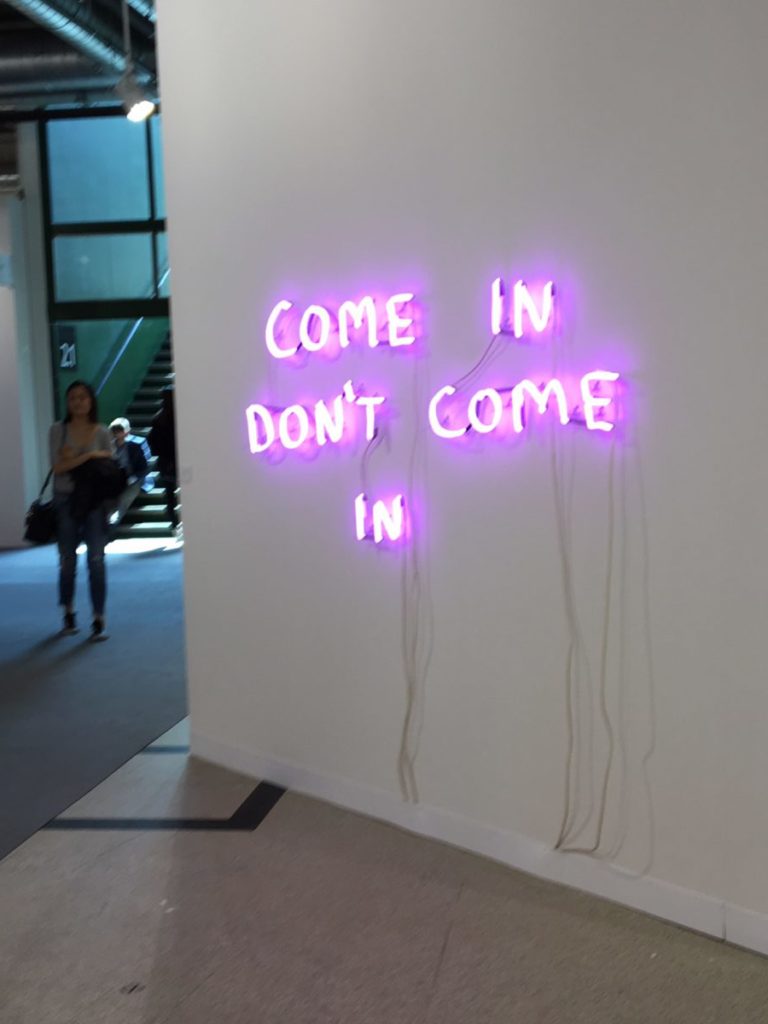
At Art Basel. David Shrigley, neon sculpture, 2018, Anton Kern Gallery. Photo courtesy of Judith Tolnick Champa.
In works not overtly concerned with politics, artists well-known to American audiences also were prominent. Always impressive were the late French-born Arman, Brazilian Lygia Pape, and American Fred Sandback, the latter represented by double-dated installations in tributes to their precocious talent and sculptural delicacy respectively using golden threads and black yarns, while Arman’s accumulation of 60 coat racks was a rarely seen environmental installation.
Sam Gilliam’s special installation for Unlimited, presented by David Kordansky Gallery of LA, Untitled, 2018, created a fluid space of suspended, saturated, fabric bolts as hanging volumes. Untitled was prominently heralded in Basel’s art fair while its museum presented The Music of Color, an exhibition of Gilliam’s work from 1967-73, his first solo museum show in Europe.The Swiss encounter with the Other, in this invigorated period of Black Lives Matter, was magnified by this recognition of Gilliam’s courageous gift for beauty and toughness, even if his ultimate goal became a striving toward an uneasy composure like that manifested in the self-portrait renamed Composed, formerly Dark As I Am, 1968-74, that was the exhibition’s emblem.
Among the many sincere practices and platforms of Art Basel, and art’s public role in contrast to the conspicuous marketing to private clients or to museum curators’ collection building, there was a clear taking on of urbanism, specifically promoting discussions about “use and ownership of public space,” as publicity described. Creative Time’s project Basilea, its first international commission and the first project by Elvira Dyangani Ose, Senior Curator, featured a local and recycled materials pavilion collectively built through the Recetas Urbanas collective. It was constructed on the pedestrian Messeplatz, precisely for exchanging ideas about the city as a public space. Nearby The Gravel Pits of Basel, by artist Lara Almarcegui, concerned the unsustainable (toxic) consequences of gravel extraction in/around Basel’s quarries, concomitant wastelands where battles over mineral rights and more are waged. In NYC a large and growing pile of gravel would not be notable at all, but in the cleanliness of Art Basel plaza, the piece was intentionally disruptive and important.
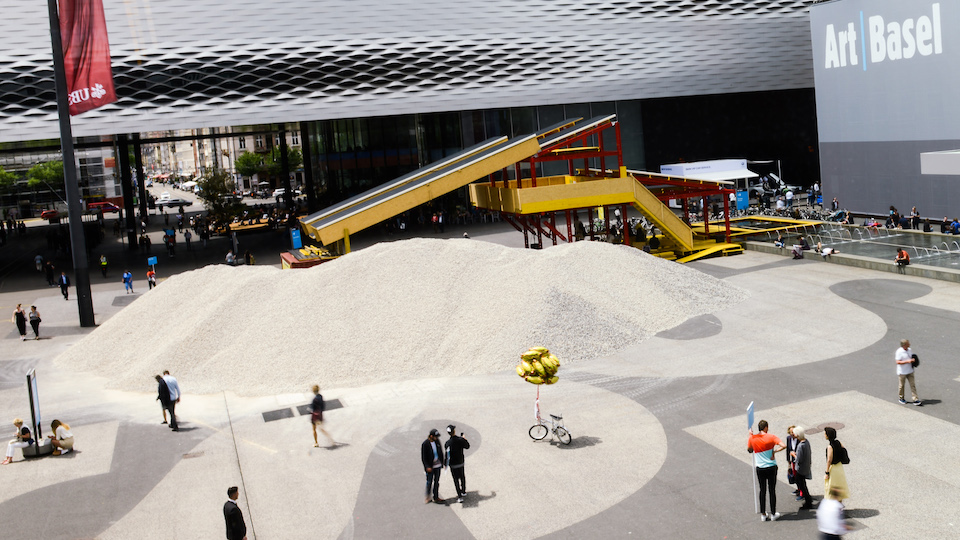
Basilea via Creative Time.
Investing in public art versus the conventional private art marketplace may still seem to be alternative propositions for Art Basel. Yet these alternatives have meshed increasingly in modern and contemporary western European presentations, marking a porousness of public and private. In Vienna, Rachel Whiteread’s Holocaust Memorial to the Austrian Jewish Victims of the Shoah, 2000, on the Judenplatz, is a concrete block, an impenetrable library occupying a site once the core of the Jewish community, at the center of the small square. Today there is essentially no space for any activity unrelated to contemplating the sculpture. I understood a special Whiteread sculpture exhibition (organized by Tate Britain, National Gallery of Art, Washington, with the St. Louis Art Museum and Belvedere), mounted this summer in Vienna’s nearby Belvedere 21, as an intentional tribute to the lasting immediacy of this memorial for the Viennese, profoundly private in being publicly sited.
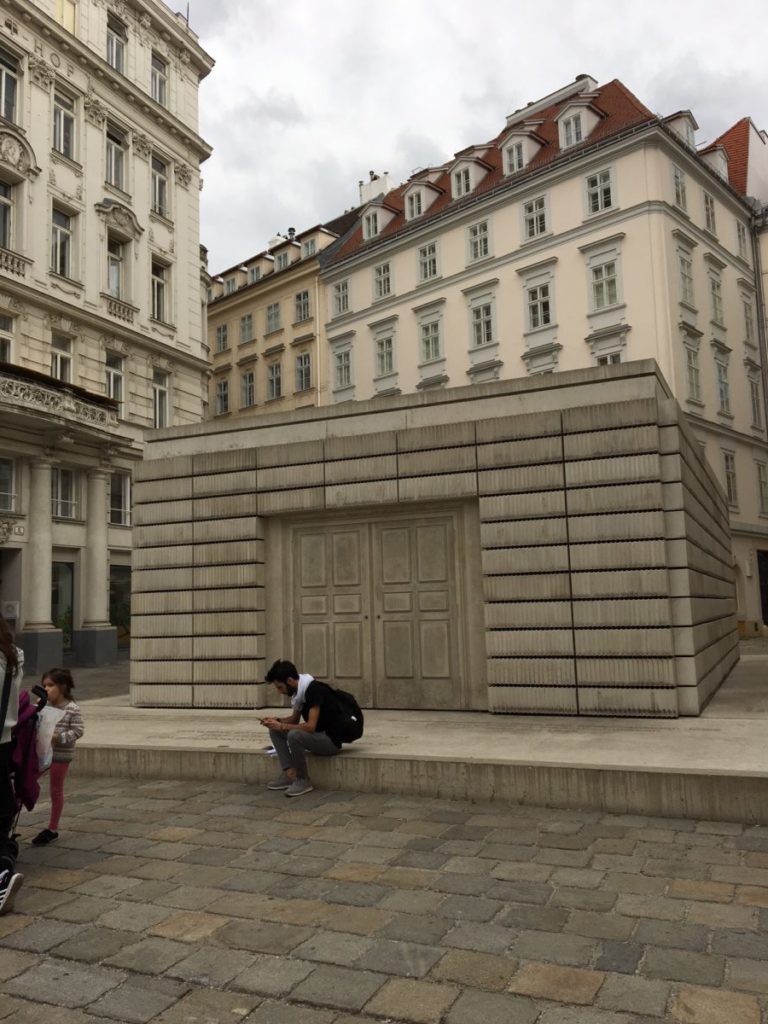
Rachel Whiteread, Holocaust Memorial. Photo courtesy of Judith Tolnick Champa.
In Basel, the interface of public and private is a given. The city houses the highest/densest number of philanthropic foundations anywhere, of which Swiss marketing materials hold that autonomy and donor freedom are especially privileged. Charitable giving is outstanding and obvious, as is multilingual pride in the city. The Fondation Beyeler (of late art patron Ernst and Hildy Beyeler’s vision) has evolved into a dual museum, in a lush countryside setting,and public art program led by Sam Keller, former director of Art Basel. The museum’s ongoing Giacometti- Bacon exhibition, emphasizing investigations of figures in space, is not a conventional monographic Alberto Giacometti exhibition and does not at all compete with the current Guggenheim exhibition in New York. Strictly curated, it smartly focuses on a relationship with Francis Bacon previously untreated by a major museum loan exhibition, and leverages Giacometti’s later figurative work, so that Woman with Her Throat Cut, 1932, albeit part of the permanent collection at the nearby Basel Museum was necessarily, alas, excluded. The latest public art commission under the aegis of the Beyeler, Ernesto Neto’s installation, the astonishing GaiaMotherTree, recently opened at the Zurich train station. The immersive handmade structure was fabricated with indigenous communities in the Brazilian Amazon, exotic to an American trained eye as for the Swiss.
Reaching outward, sustaining its modernist past but pressing forward, is also what drives the Museum Tinguely on the Rhine, in essence a permanent homage to Swiss born Jean Tinguely, who spent his childhood in Basel. His friendship and sometime collaboration with Yves Klein and are among many fascinating threads narrated in the klanging, “mechanical disorder” (Pontus Hulten) multi-floor, viewer participatory environment, participatory before the term came into common institutional use. Here one personally activates the meta-mechanical reliefs and automata, to co-perform the work. Ensuring temporary exhibitions in the uninhibited spirit of Tinguely’s approach, during art week Too early to panic by the Swiss artist duo Gerda Steiner & Joerg Lenzlinger took on the natural world as a wildly immersive Wunderkammer-Labyrinth both inside and outside the museum.
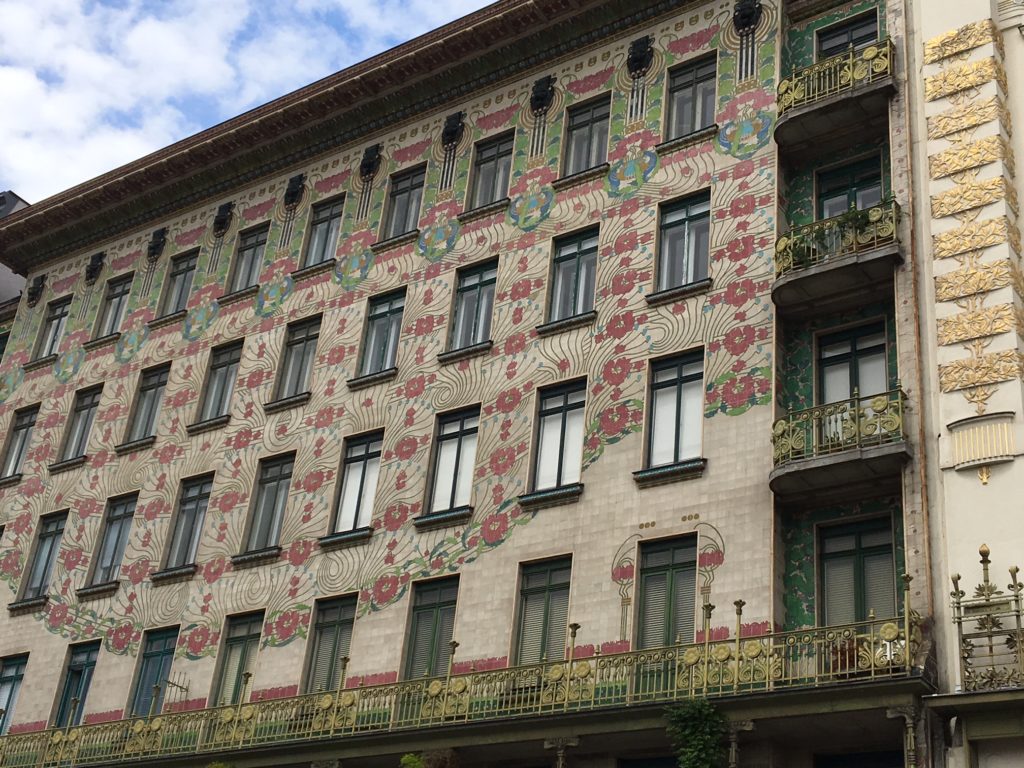
Otto Wagner Apartments. Photo courtesy of Judith Tolnick Champa.
Within both private and public realms, the art I encountered in Basel and Vienna was prospective and retrospective, extroverted and introspective. Contemporary artists are frequently unpredictable, migratory, and, evident in many artists’ working today, increasingly transmedial, experimenting non-hierarchically with whatever media (or patronage) expressively suits them to explore, as they comment on various conditions of being in the world. These creative results move us beyond traditional binaries of the marketplace, to erode its margins and posit new connections. An exciting and liberating way forward in the artworld likely emerges from this growing conjunction of private and public.

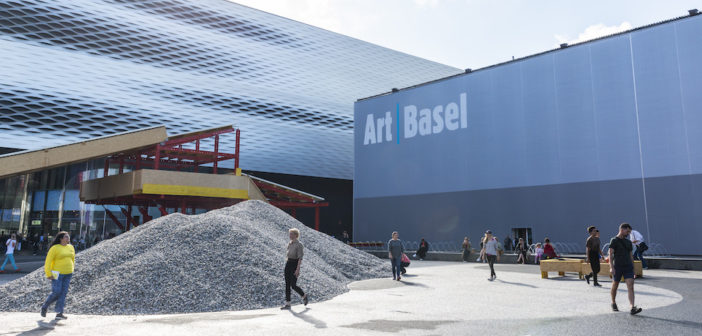
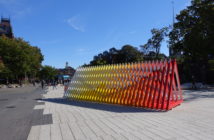
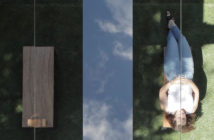

1 Comment
Thank you for this. Really intrigued by “The Gravel Pits of Basel,” and its recognition that the city’s life and footprint extends beyond what is ordinarily imagined.